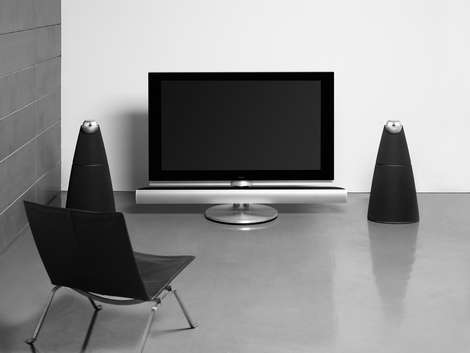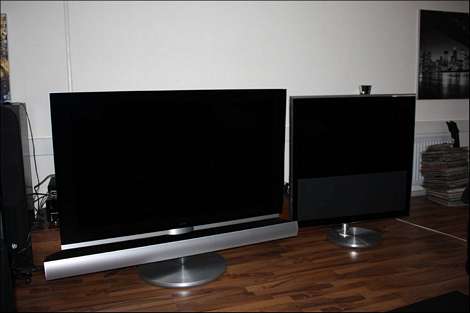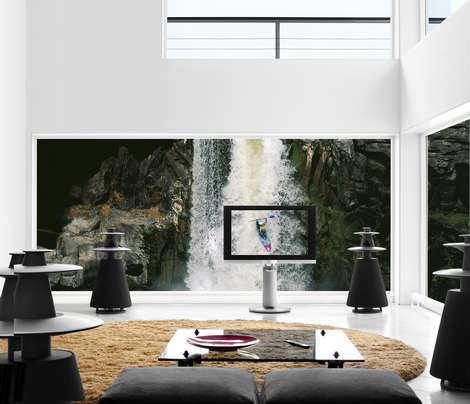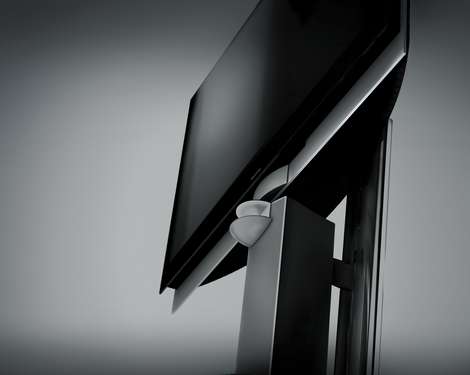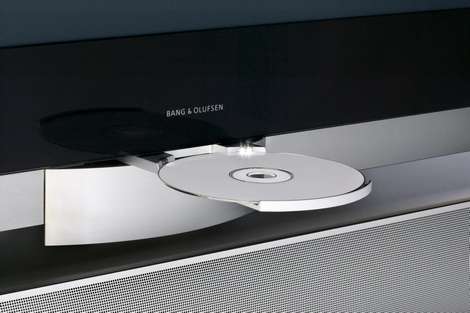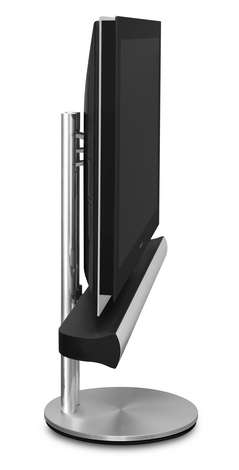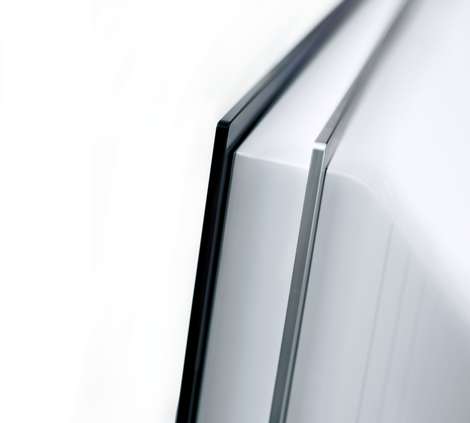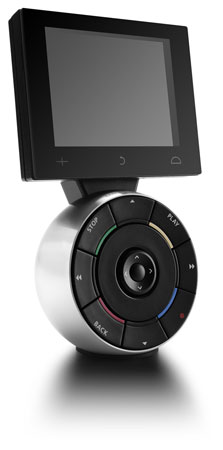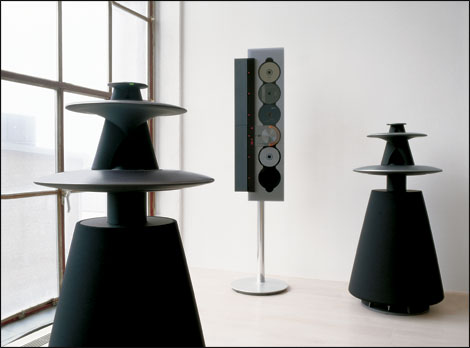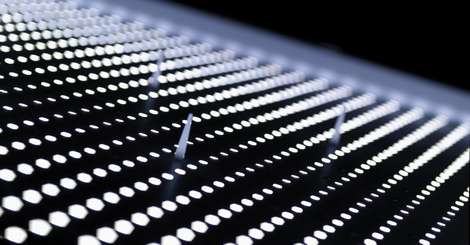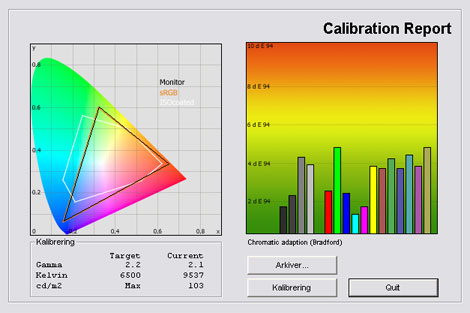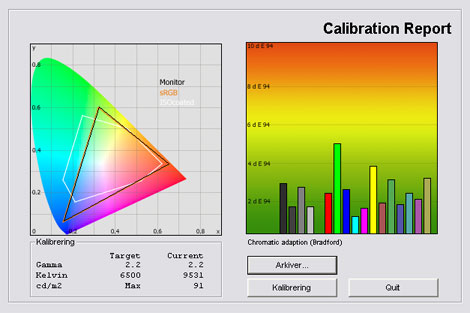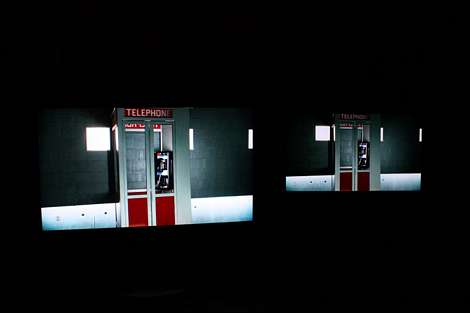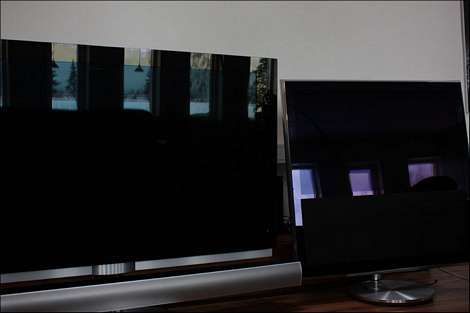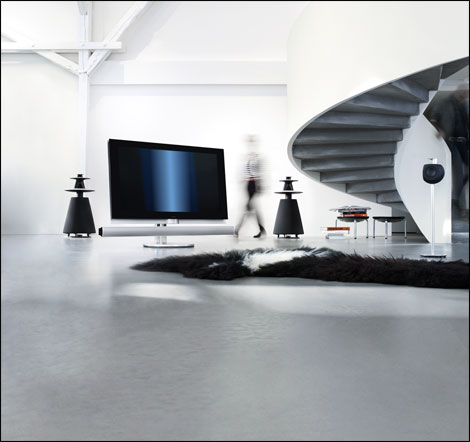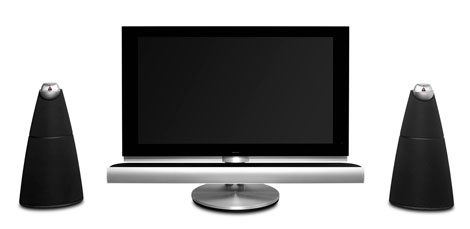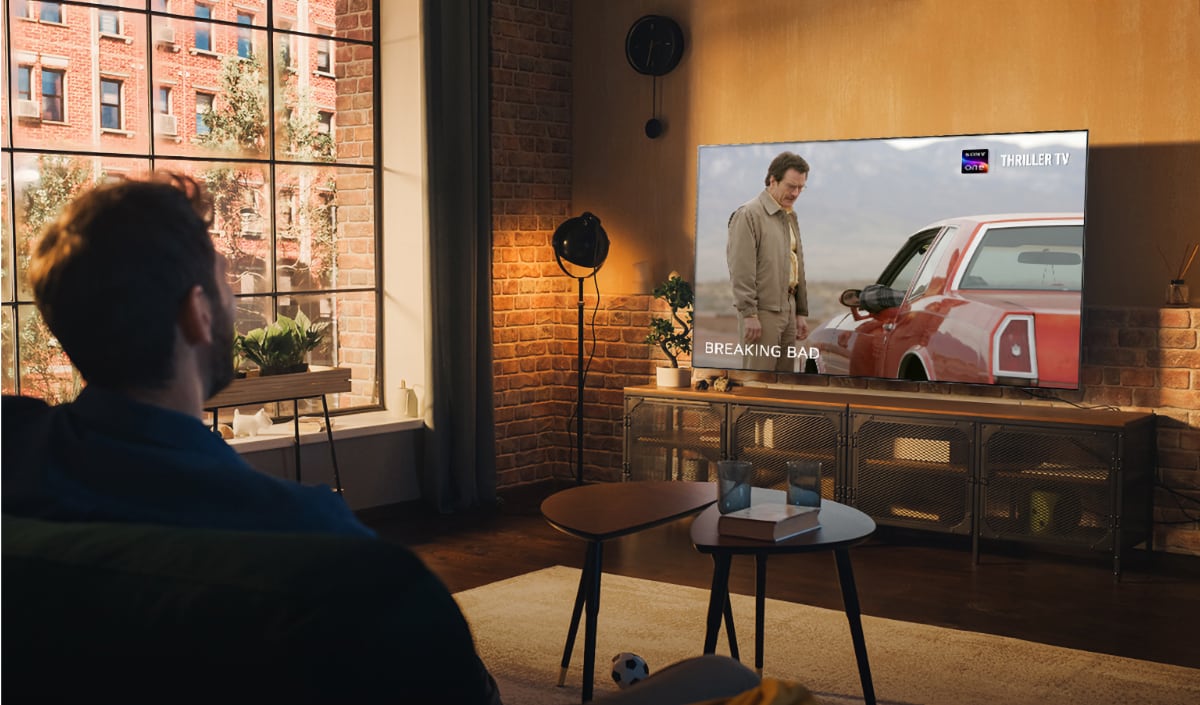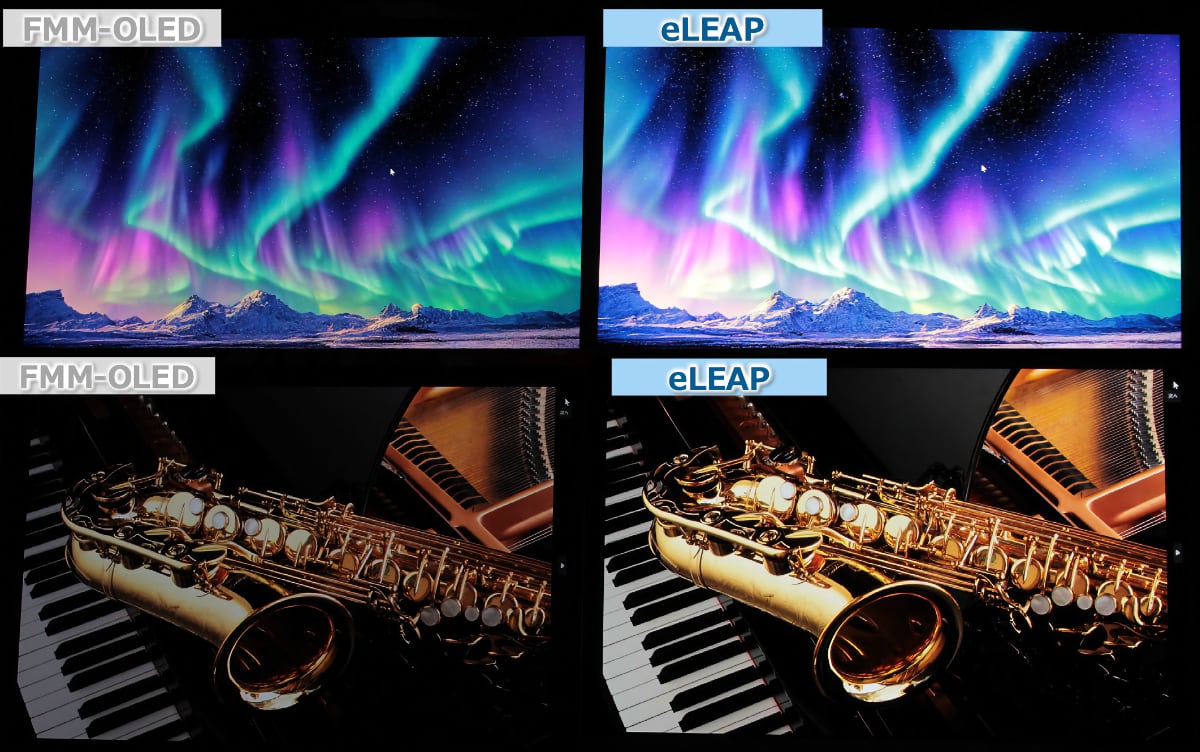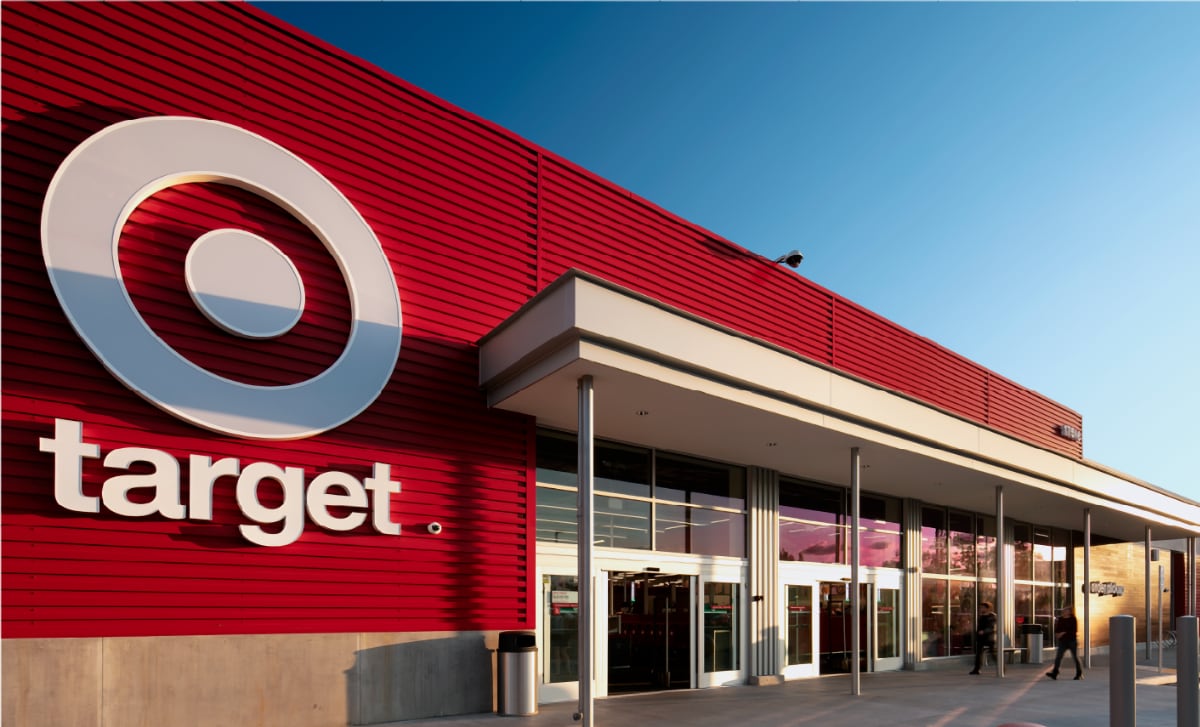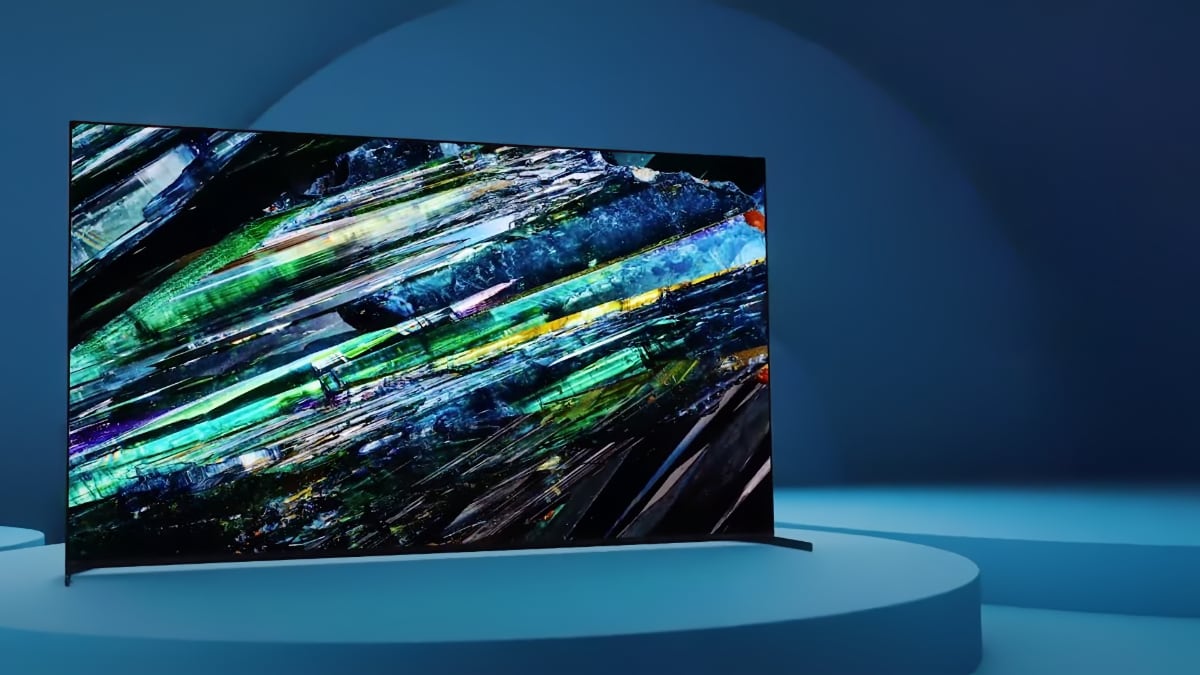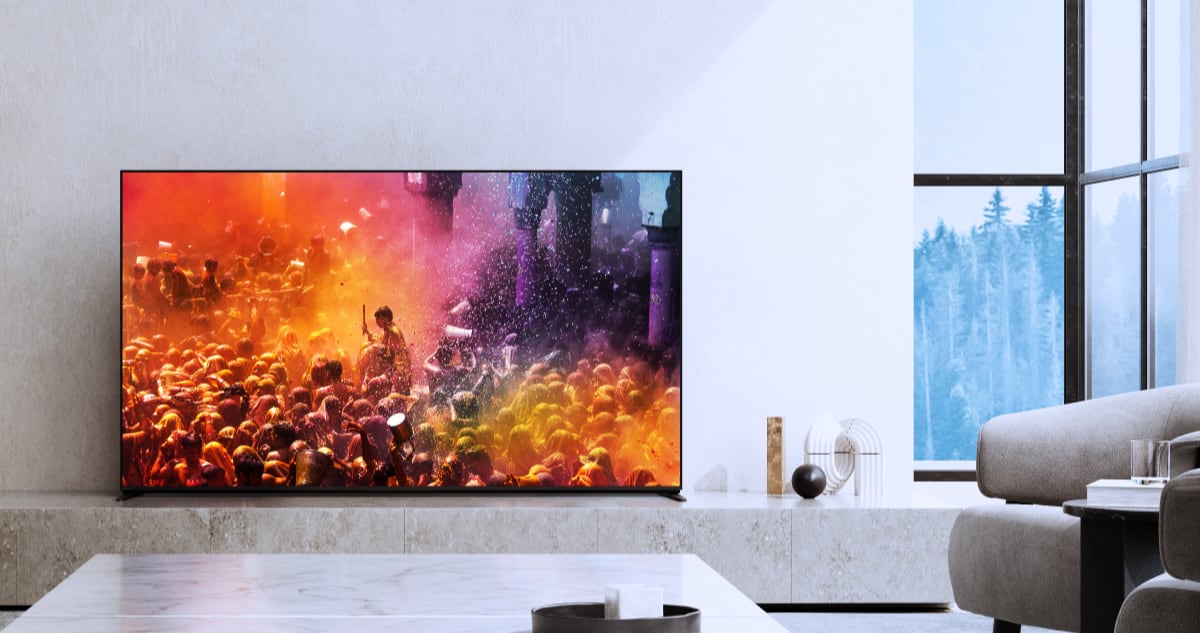B&O BeoVision 7-55
Bang & Olufsen BeoVision 7-55 review
A new member has joined the BeoVision 7 family - Bang & Olufsen’s most popular range of flat screen TVs. The new addition measures an impressive 55" and is called the BeoVision 7-55. In itself, 55 inches is big, but the BeoVision 7-55 also features a surprising amount of innovation.
In fact, the BeoVision 7-55 is a technological marvel, with LED backlight and local dimming, a feature that enables Bang & Olufsen to control the light on the screen in several zones so as to create areas of deeper black and improved depth in the image. In addition, the BeoVision 7-55 boasts scanning backlight and 100 Hz, which is expected to improve the reproduction of fast sports and action scenes.
The BeoVision 7-55 builds on the familiar BeoVision 7 design and in the centre of the unit, Bang & Olufsen has integrated a Blu-ray and DVD player, which interacts with the 7.2 integrated surround amplifier. This all sounds very promising, and with a suggested price of $18,700 (depending on that extra equipment you want), the BeoVision has seriously high expectations to live up to.
But how does the BeoVision 7-55 perform when push comes to shove? Does it live up to the Bang & Olufsen and BeoVision 7 reputations, and what do you actually get for the price? And where does the BeoVision 7-55 stand in relation to the BeoVision 10, which was the subject of our most recent review?
More reviews from FlatpanelsHD.com here
BeoVision 7 is also available in 40 and 32-inch models under the names of BeoVision 7-40 and BeoVision 7-32, but these versions do not feature all the new image circuits that are to be found in the BeoVision 7-55.
Panel size: 55,5" widescreen (LCD LED) Resolution: 1920x1080 Response time: 6 ms (g2g) Contrast ratio: 4000:1 (static) Brightness: 500 cd/m2 Colour support: 16,7 million colours Signal processing: 8 bit for each colour Viewing angles (H/V): 178/178 Dot pitch: - Panel type: LCD LED (Samsung) Wall mounting: Swivel stand: Dimensions (HxWxD): 87.5cm x 140.8cm x 18.4cm (witout stand) Weight 75 kg Built-in speakers: Input formats: 480p/i, 576p/i, 720p, 1080i & 1080p (50, 60 & 24p) Inputs • VGA • DVI (can be converted through HDMI)
• Audio (type) (Audio in/out)
• SCART (2 inputs)
• S-video • Composite • Component 
• HDMI (4 inputs)
• Other Outputs • Audio (type) (1 output)
• SCART • S/PDIF (7 powerlink)
Tunere • Analog • DVB-T • DVB-T (MPEG4) • DVB-C • DVB-C (MPEG4) • DVB-S • DVB-S (MPEG4) Other: Built-in Blu-Ray / DVD First impressions of BeoVision 7
BeoVision 7 is Bang & Olufsen’s most popular range of flat screens, and the company has launched models in different sizes over the years. Never before has a genuinely big screen BeoVision model been available, but the BeoVision 7-55 measures an impressive 55 inches and thus approaches the size range in which Bang & Olufsen’s plasma TVs have dominated to date.
The BeoVision 7 design is well known and recognised for its elegant and simple presentation. The entire front panel is made from a single piece of glass so that the screen panel and the frame form a single unit. This creates an elegant impression that other manufacturers have since attempted to replicate – most recently LG, with its borderless design. Aluminium edging is revealed behind the front frame, ensuring that the BeoVision 7-55 is flamboyant not only from the front, but also from the side.
We placed the BeoVision 7-55 on the low, motorised stand that positions the BeoVision 7-55 close to the floor. However, this low position is counterbalanced by the 55-inch size, because 55" is big. The BeoVision 7-55 succeeds in converting the 55 inches into a piece of furniture, which is not ashamed of what it is, but simultaneously comes across as an extremely attractive piece of craftsmanship.
BeoVision 7-55 vs. BeoVision 10
The 55-inch size naturally takes up a good deal of space in the living room, so the BeoVision 7-55 cannot be relegated to an obscure corner. It instantly captures the attention of anyone who enters the room, and the TV simply radiates quality thanks to the sublime choice of materials.
At the same time, the BeoVision 7-55 is a manifestation of Bang & Olufsen’s focus on picture and audio quality. Nothing has been left to chance, and the BeoVision 7-55 will not “make do”. For this reason, the BeoVision 7-55 is somewhat thicker than the current trend on the flat screen market, which means that the model is the “fat boy in the class”.
However, the “fat boy” has nothing to be ashamed of; even though the cabinet is generous, the design and execution are truly beautiful. The BeoVision 7-55 makes no claim to be a fashion icon, because fashion soon goes out of fashion. In contrast, it radiates style – and style is for ever.
The motorised stand itself is a feature that quickly captures the attention. Even though the base is heavy and stable, and even though the BeoVision 7-55 is a weighty item, the ergonomic functions make the television appear light as a feather.
Pressing a couple of buttons on the remote control unit is sufficient to turn the BeoVision 7-55 from side to side with a silent, fluid motion. It is even possible to adjust various settings for video, audio and stand-by so that the BeoVision 7-55 turns to different positions depending on use. And as if this were not enough, the remote control can be used to instruct the motorised stand to tilt the BeoVision 7-55 forwards or backwards.
But the BeoVision 7-55 has even more to offer. In the centre of the front panel, you will notice a small arch, which hides a secret. When you pass a hand in front of a sensor on the base of the BeoVision 7-55, the whole thing opens and an aluminium drawer slides out, illuminated by small diodes. This aluminium drawer is ready to receive your home entertainment media in the form of both Blu-ray and DVD. The integration is magnificent and nothing remotely similar is yet to be found in other flat screens.
Just like many other Bang & Olufsen flat screens, the BeoVision 7 range is very versatile. You can choose between a variety of stands and speakers. For this test, we used the elongated BeoLab 7-6 speakers, which break up the rectangular symmetry of the screen and generate an interesting interplay. If this is not to your taste, you could choose BeoLab 7-4 speakers, which are triangular and have replaceable front panels that allow you to change the colour.
All the screen input and output sockets are located at the back and face downwards. They can be concealed by the rear panel to keep the cables out of sight. The BeoVision 7-55 has four HDMI inputs, but two of them are already used by the DVB-HD tuner and the Blu-ray player. It looks a little odd that two of the HDMI inputs have already been “stolen” by the TV’s built-in components, so it is fortunate that you will not be watching the BeoVision 7-55 from the rear.
It is also at the back that you will find seven PowerLink outputs to the associated Bang & Olufsen speakers.
Unsurprisingly, the BeoVision 7-55 has been designed by David Lewis. The picture below shows the BeoVision 7-55 next to the BeoVision 10. As you can see, the difference is more than just a couple of centimetres.
BeoVision 7-55 vs. BeoVision 10Test tools
Our TV signal is DVB-S (satellite) from Canal Digital and DVB-T (terrestrial). We also have an analogue TV connection.
Testing is done with the DVE (digital video essentials) and Peter Finzel test DVD. Testing is also done with DVD, TV, Blu-Ray and Mediacenter/PC.
We also use our own monitorTest . The software supports some of the traditional test patterns used to evaluate displays as well as some new and unique test patterns developed by the people here on Flatpanels.
Sony PlayStation 3 is our Blu-Ray player.Functionality
For the test, we used the Beo5 remote control. This is the replacement for the familiar Beo4 remote control, which will, however, remain available on the market. We have already described the Beo5 remote control in our review of the BeoVision 10, so we will not be going into details about its functionality here. Instead, you can read our review of BeoVision 10.
The BeoVision 7-55 features a built-in Blu-ray and DVD player, which is concealed behind the curved centre section on the front of the screen. The integration is extremely elegant, and if you do not know that the unit features a Blu-ray player, you will barely notice it. You can of course use the remote control to open and close the Blu-ray player, but the function can also be activated by passing your hand in front of a sensor in the base of the screen. It is a cool function that works very well.
Accessing this feature reveals an aluminium drawer illuminated by two diodes, and you can then simply place your Blu-ray, DVD or CD in the drawer. If you insert a video disc in the BeoVision 7-55, the screen displays a pause image before the TV automatically presents the menu from the DVD or Blu-ray disc. The load time could have been reduced, though!
The start-up times for CD, DVD and Blu-ray reproduction are listed below:
CD: 16–10 seconds
DVD: 22–24 seconds
Blu-ray: 44–47 seconds
The rear panel of the BeoVision contains seven PowerLink outputs, which means that you can connect up to seven Bang & Olufsen speakers. If, for example, you have two listening positions for music – one in front of the TV and one on the sofa – you can set up the system to change the audio field to suit your needs. Therefore, if you wish to watch television, the speakers next to the TV can act as front speakers, while the other speakers can take on this role when you are sitting in your other sofa, listening to music.
I do not want to go into too many details about the link options to be found in Bang & Olufsen’s products, primarily because I do not have any Bang & Olufsen products here other than the BeoVision 10 and BeoVision 7-55, but also because this review principally focuses on the picture and audio quality of the BeoVision 7-55 itself.
The Bang & Olufsen menus are simple enough, but if you are used to using other TV navigation menus, they may take a little getting used to. The screen menus do not provide viewers with great freedom to adjust the picture. Generally speaking, it is only possible to work with brightness, contrast and colour. The menus are not shining examples of graphic design, and look pretty much the same as the usual Bang & Olufsen menus. It may soon be time for a graphic overhaul.
Bang & Olufsen does use some more advanced menus, although these are not directly accessible because the Bang & Olufsen picture circuits largely deal with many of the tasks that users will generally want to work with. These menus also contain demonstrations of how LED with local dimming functions, and how scanning backlights work. I will return to the BeoVision 7-55 picture systems in the section devoted to picture quality.
The BeoVision 7-55 also features two digital tuners – DVB-T (terrestrial TV) and DVB-C (cable TV). These can also receive HDTV because they support MPEG4 format, which means, for example, that viewers in Denmark can watch DR HD. The digital EPGs work well, but I have seen better graphic performance.Power consumption
The measurements for the Bang & Olufsen BeoVision 7-55 are presented below:
| Out-of-Box | After calibration | |
| Standby | 0,8 W | 0,8 W |
| SD | 160,6 W | 154,8 W |
| HD | 160,6 W | 154,8 W |
There is not a vast amount of difference between the Bang & Olufsen BeoVision 7-55 standard settings and calibrated settings. The main reason for this is that the BeoVision 7-55 features an automatic light sensor, which adjusts the light on the basis of the surroundings. The figures above were calculated as a mean figure on a cold winter’s day, with measurements taken in daylight in the middle of the day and in the evening.
The measurements were also taken without the speakers in use. I have chosen not to measure with the speakers in use because many Bang & Olufsen users prefer to connect external speakers to BeoVision 7 models.
A figure of 154.8 W after calibration is certainly a good result for a TV of this size. By way of comparison, the LG 50" 50PS8000 uses 221 W after calibration, although the figure for the Sharp 52" LE700 is as little as 106 W.
Picture quality on BeoVision 7-55
Before going on to talk about the picture quality, I would like to introduce this section with some explanations of the technical systems that the BeoVision 7-55 contains.Hardly any of the other flat screen manufacturers have succeeded in achieving a technological level to match that of the BeoVision 7-55, and only the The Philips 9704H range currently features the same LED backlight, local dimming and scanning backlight functions.
One of the most interesting aspects of the BeoVision 7-55 is an LED backlight with local dimming. The manufacturer has chosen to use diodes (LED) rather than the fluorescent lights that have conventionally been used to illuminate LCD panels.
This provides a range of advantages and opens the door to what is known as “local dimming”.
Local dimming involves distributing LEDs across a larger number of zones behind the LCD panel itself, with it being possible to control each zone individually. In this way, it is possible to reduce the brightness in a zone on the screen panel that requires a very deep reproduction of black (e.g. a shadow) while simultaneously intensifying the light in a different zone that requires a lot of light (e.g. an image of the sun or sky).
This can help to generate remarkable contrast in the picture and create very deep reproduction of black. The BeoVision 7-55 has a demonstration function that illustrates how LED with local dimming works. The function turns off the picture and shows only what happens in the LED backlighting and the numerous zones. I have recorded a film of this (see below) to illustrate how LED with local dimming functions in practice. The clip is a trailer for Transformers 1. Note how the light varies greatly across the screen zones, depending on how much light is required during the Transformers trailer.
The BeoVision 7-55 also features a built-in scanning backlight system which, together with the 100 Hz, is intended to reduce blurring and make fast sports and action scenes even crisper. We have previously seen that scanning backlight has an appreciable effect on the reproduction of fast scenes on LCD TV, and we will take a closer look at the system later on in this section.
I will now continue measuring the picture quality of the BeoVision 7-55 out of the box. I will then attempt a minor calibration and continue to discuss the picture quality in practice. The figure below presents my analysis of the BeoVision 7-55 picture quality out of the box.
The graph says this:
The number on the left is the delta value. Delta is a difference between two factors; here it’s the difference between the measured colour on the panel and the actual colour that is our target.
The picture quality on the BeoVision 7-55 out of the box is impressive. The deviations in the colours are extremely modest in relation to those presented by most of the TVs we test here at FlatpanelsHD. Gamma is slightly too low, ranging from around 2.05 in the light colours to 2.15 in the darker shades. However, this is not a critical deviation, and the spread from 2.05 to 2.15 is very small, which is positive. The situation is much worse if gamma fluctuates more markedly between the lightest and the darkest colours.
The problem with standard settings, however, is the high colour temperature of slightly more than 9000 Kelvin. We are aiming for 6500 Kelvin, and the 9000 Kelvin of the BeoVision 7-55 result in a colder, more bluish picture, whereas our reference temperature of 6500ş Kelvin produces a warmer, redder picture.
This is a consistent choice on the part of Bang & Olufsen, and has been identified in numerous consumer tests. We saw it in our tests of the BeoVision 10 and the BeoVision 8-40, but I am still not entirely in favour of this disposition.
Apart from the high colour temperature and the slightly low gamma, I would like to praise the BeoVision 7-55 for an excellent result. As far as I recall, this is the best out of the box measurement I have yet made on a TV, and the BeoVision 7-55 presents a more accurate picture than the BeoVision 10 from the very start.
I then continued my test by performing a calibration of the BeoVision 7-55. However, the calibration process is severely limited by the fact that Bang & Olufsen’s menus are very simple and lack a number of picture settings. These settings can be accessed via the screen service menu, but I chose not to base my test on this (and we do not recommend that users enter the service menus on flat panel TVs).
Through the calibration I performed, I succeeded in improving gamma, bringing it closer to our target of 2.2. Gamma still varies from 2.10 in the lightest colours to 2.2 for the darkest, but this has little effect in practice. What it means is that the lightest colours are marginally too bright, but not to such an extent that viewers would notice.
I did not succeed in making any significant improvement to the colour temperature, which means that the BeoVision 7-55 retains a picture that is slightly colder and bluer than our objective. Bang & Olufsen think that viewers prefer this, but I would still like to see a setting option that allows the user to change the colour temperature to 6500 Kelvin – for example a movie profile that can be activated when you are enjoying a movie.
The table below presents my settings after calibration:
| After calibration | |
| Light: | -3 |
| Contrast | -3 |
| Colour: | 0 |
| Size: | In the middle |
The “Light” setting controls the gamma process on the BeoVision 7-55, while the “Contrast” setting controls the actual brightness on the screen. I have reduced “Light” three steps to improve gamma slightly, and I lowered “Contrast” a little to produce a picture with slightly less brilliance.
The BeoVision 7-55’s light ouput was slightly higher than that of the BeoVision 10 to start with. However, it should be noted that the BeoVision 7-55 automatically adjusts the light in relation to the surroundings, turning it up during daylight and dimming it in the evening and at night.
In practice, I saw a very attractive picture. The BeoVision 7-55 features a remarkable level of detail, and the colours are fine and delicately shaded – if a little too blue. I also saw magnificent depth and dynamism in the picture reproduction. The reproduction of the colour black is very deep – even when the screen is showing bright images – and this creates a neat contrast and a wonderful depth effect in the picture, which I mentioned previously in my review of the Pioneer Kuro.
This is attributable to the screen’s LED backlight with local dimming, which allows Bang & Olufsen to control the light on the screen in multiple zones. With this technology, the light can be dimmed in those places on the screen that require a very deep black.
I have previously looked at local dimming in connection with my reviews of the Philips 9704H and 9803H, and I found that it certainly does result in a very deep reproduction of black. However, it tended to wipe out all the details in the darkest colours on Philips TVs – these colours were simply shown as pure black.
Through sporadic use, I did not encounter the same problem with the BeoVision 7-55, but I will continue to examine this feature in depth following my measurements of the screen’s black level. Nevertheless, I see clearly that the Bang & Olufsen BeoVision 7-55 makes much more of the LED and local dimming system than the Philips 9704H.
Naturally, standard analogue TV signals are not suited to projection in gigantic 55" format, but in the same way as I praised the BeoVision 10 for producing a decent picture from even poor signals, I must also praise the BeoVision 7-55 for achieving equally good results from poor signals. This is, in itself, a demanding task for a screen that fills 55 inches.
Digital signals produce an even better picture, but the BeoVision 7-55 first really comes into its own when working with HDTV signals, Blu-ray or games from an HD games console such as PlayStation 3. Here, the BeoVision 7-55 really flexes its muscles and it is magnificent to see how Bang & Olufsen yet again succeeds in producing excellent picture quality from its LCD technology.
HD on this TV is quite simply an extraordinary pleasure. The HD experience is further enhanced by the fact that the TV measures 55 inches. The HD standard can certainly cope with even bigger screen formats, but if you upgrade from the typical 40 inches to 55, you will encounter a whole new world of small details that were previously hidden by the constraints of the “modest” dimensions of 40-inch screens.
The picture features an incredibly rich level of detail and finely shaded colours.
I ran a number of colour grades via our test programme, which shows colour transfers from, for example, black to red, black to green and black to white. Again, the results were impressive, and the BeoVision 7-55 succeeds in capturing more-or-less all the small steps in colour. There is a slight tendency to problems with the mid-range green shades, but this is in no way critical.
I then continued to examine the response time and the way in which the BeoVision 7-55 deals with fast movements. As most people are aware, football matches and fast action scenes in films are tough for flat screens to deal with, and this type of action often causes the biggest problems for flat screens.
Bang & Olufsen has implemented what is known as a scanning backlight system – which we also saw in the LG SL8000 range – in the BeoVision 7-55. On LG’s SL8000 model, this resulted in a clear improvement in the response time.
The introduction of the scanning backlight system also produced a marked improvement in the response time in the BeoVision 7-55, although not quite on a par with that of the LG SL8000. This is probably due to the fact that the SL8000 is based on an LCD panel with what is known as an IPS (In Plane Switching) panel, while the BeoVision 7-55 uses a PVA (Pattern Vertical Alignment) panel, which defines the arrangement of the small fluid crystals in each pixel.
However, the BeoVision 7-55 presents a good response time, and this contributes to a high level of detail in even very fast scenes. Football is a delight to watch, and action films are not diminished by the problem of blurry motion which often plagues LCD TVs. That said, the BeoVision 7-55 is not completely successful in eliminating blur, which can be spotted by the most critical eyes. For example, I noticed a touch of blur when a black object moved across a grey background.
On the subject of the response time, I would like to say a few words about the 100 Hz system. In the same way as in many other TVs, the 100 Hz system contributes to presenting a smoother, more fluid picture. Bang & Olufsen does not suffer from the slightly unrealistic and pseudo-like effect that affected the first 100 Hz systems on the market, and with which Samsung in particular experienced great difficulties in its TVs.
The 100 Hz system is not, however, perfect and can introduce a little grain around fast movement – when a football is kicked across the pitch, for example.
When using a games console, I experienced less input lag (delay of the signal) from the BeoVision 7-55 than I encountered on the BeoVision 10. If you deactivate the 100 Hz system on the BeoVision 7-55, you can reduce input lag even further, without compromising the reproduction of fast movements (on account of the scanning backlight).
The interaction between the scanning backlight and the 100 Hz systems generates a fantastic effect. The BeoVision 7-55 features stability and natural reproduction of movements that few other TVs can match, and this contributes to the perception of a really attractive picture.
The table below presents my measurements of black reproduction:
| Out-of-Box | After calibration | |
| Black level | 0,0 cd/m2 | 0,0 cd/m2 |
| Brightness | 103 cd/m2 | 91 cd/m2 |
| Contrast ratio | - | - |
Contrast ratio +/- 50
I have previously subjected my measuring equipment to tough tests with the Pioneer KURO plasma TV and the The Philips 9704H range, where the equipment actually had to give up because the black level was too deep to measure. This was also the case with the Bang & Olufsen BeoVision 7-55. My measuring equipment simply displayed “0”, indicating that it was not registering anything at all.
This is interesting, because during my test of the Pioneer KURO, the equipment recorded a measurement of 0.02 cd/m2. It is true that 0.02 cd/m2 is the lowest that my equipment can measure, but it nevertheless indicated that the KURO did allow some light to slip out of the black shades, allowing the equipment to round up to 0.02 cd/m2.
My test of the BeoVision 7-55 produced a measurement of 0.00 cd/m2, which indicates that absolutely no light slips through – or so little light that the equipment rounded down to 0.00 cd/m2 rather than rounding up to 0.02 cd/m2. This means that the black level of the BeoVision 7-55 is absolutely fantastic – approaching perfection, in fact.
Of course, the way in which black is reproduced in a still image is one thing; how it is reproduced in practice is completely different. This is something I mentioned previously in this section. The local dimming system unfortunately generates “halos” (i.e. white rings around light objects on a completely black background). We encountered this problem in the The Philips 9704H, and before that in the Samsung 9 range with local dimming.
Naturally, I examined this issue in the BeoVision 7-55 as well, and have to state that Bang & Olufsen has not succeeded in eliminating the halos. The pictures below illustrate this point. The picture to the far left shows a pause logo without a halo, and the one to the right shows the same logo with the halo effect (you might want to look at the picture below in the evening because it can be hard to see the effect in the daytime on an non-calibrated PC monitor).
All these pictures are taken from the BeoVision 7-55. The picture to the left is taken from directly in front, the picture in the middle from a slight angle, and the picture to the right from an angle of 35–45ş. The halo effects are not very visible from directly in front, which is attributable in part to the panel and in part to the glossy contrast surface that the BeoVision 7-55 uses. However, they become clear if you are viewing the TV from an angle.
So if you are viewing the BeoVision 7-55 from directly in front, you will not be overly irritated by the halos – even though you will still notice them.
This has a minor effect on the picture quality itself, but Bang & Olufsen has succeeded in reducing the halo effect slightly in relation to the models from Philips and Samsung that I have examined. However, the halos are one of the problems that still exist in the context of LED local dimming technology.
Finally, it is time to examine the phenomenon of “clouding”. This is the name of the phenomenon whereby more light comes through in the corners or edges of the screen, for example. It is a problem that has conventionally plagued LCD technology. I did not expect the BeoVision 7-55 to have problems with clouding because it uses an LED backlight where the diodes are positioned behind the LCD panel itself. This assures a perfectly homogeneous distribution of the light across the screen. But, of course, I had to check.
As expected, the BeoVision 7-55 does not in any way suffer from inhomogeneous light/clouding. In a dark room, against a completely dark background, the BeoVision 7-55 blends seamlessly in with the room. It is truly magnificent to see!
The picture was actually taken with an aperture time of more than 3 seconds!
BeoVision 7-55 vs. BeoVision 10
I had promised a number of users that I would run a brief comparison between the BeoVision 7-55 and the BeoVision 10, so I have dedicated a short section to this.Firstly, there is a huge difference in size between the two models. The BeoVision 7-55 naturally has a broader frame, but 55 inches is appreciably larger than 40 inches. Remember that the measurement is made diagonally, so a 40-inch TV is four times the size of a 20-inch TV in practice.
The larger size alone allows more room for the HD format to fill out, and this becomes very clear when comparing the BeoVision 7-55 and the BeoVision 10. In addition, the BeoVision 7-55 is slightly more brilliant from the start, so black comes across as even deeper and more intense on the BeoVision 7-55 than on the BeoVision 10, which otherwise presents good, deep reproduction of black.
Both the BeoVision 10 and the BeoVision 7-55 feature an anti-reflexive coating in the picture below. However, please note that neither of the models has this coating on the glass around the picture panel.
As regards audio reproduction, the BeoVision 7-55 sound has more base and the TV handles the bass tones in particular better than the BeoVision 10. This is already apparent at quiet levels, but the difference can be more fully appreciated when the volume is increased. Finally, the BeoVision 7-55 features more comprehensive functionality, with more connection options, seven PowerLink sockets and a stand that can also be tilted via the remote control. The settings options in the picture menu are, however, the same.
All in all, the BeoVision 7-55 is superior to the BeoVision 10 in almost every area. The picture quality is similar in many areas and generally remains fully in line with Bang & Olufsen’s picture philosophy. However, the performance of the BeoVision 7-55 is several levels higher on most aspects of the picture, which contributes to producing an eminent picture quality.
PC and media center
There were no problems in connecting a PC or a media centre. All you need to do is to make sure to select 1920 x 1080 resolution and to select “Size” in the BeoVision 7-55 menu.Viewing angles
The BeoVision 7-55 does not have perfect viewing angles, but the colour and contrast maintain a decent level even when viewed from an angle. Many LCD-TVs find it difficult to maintain the contrast from angles, which means that black often becomes grey when the screen is viewed from the side. The BeoVision 7-55 does not have this problem, and the contrast glass on the front does not diminish the viewing angles – which was the case with the LG SL9000 range.I mentioned LED with local dimming in the picture quality section, but would like to make another comment on the subject here. There are some issues with “halos” around light objects against a completely dark background, for which the local dimming system was also criticised in connection with the review of the The Philips 9704H.
Halos are visible to a lesser extent on the BeoVision 7-55 – probably on account of the contrast glass – but are mainly evident when the screen is viewed from the sides. People watching the BeoVision 7-55 head on will barely notice the halos. The extremely deep black reproduction is reduced slightly when viewed from angles – but the black reproduction from the sides is still much better than on most TVs today.
The BeoVision 7-55 can, of course, be turned from side to side using the motorised stand, but good viewing angles are still a requirement to ensure that viewers watching from the “wings” of the sofa can enjoy good picture quality. Therefore, it is positive to note that the BeoVision 7-55 delivers some of the best viewing angles we have yet seen from LCD technology. Nevertheless, there is still a way to go to perfection.
The pictures below show the screen from different viewing angles.
Sound
We used the elongated BeoLab 7-6 speakers for this review, but BeoLab 7-4 speakers provide the same sound quality.BeoLab 7-6 speakers are slightly broader than the BeoVision 7-55 TV for reasons of both design and quality. The speakers are built in a solid, heavy cabinet and testify to Bang & Olufsen’s focus on superior sound quality.
The speaker has to deliver more than for any other flat screen TV, and Bang & Olufsen promise a marked improvement on the BeoVision 10 and BeoVision 8-40 speakers. The company claims to have improved the sound field primarily with regard to the deep bass tones and the mid-range tones, so on this basis we wound up our familiar and much-loved pieces of music, which we have listened to on more than one occasion.
And the verdict? The audio reproduction from the BeoLab 7-6 is delightfully differentiated. It succeeds in creating a beautifully atmospheric sound field with excellent mid-range and bass tones. And the effect does not diminish when you turn the music up.
The BeoLab 7-6 continues unabated, and the bass tones in particular are a great improvement on the sound from the BeoVision 10. There is a noticeable difference, but it would almost be a shame to call the BeoLab 7-6 a flat screen speaker. It is pretty much an external speaker, which allows a little more room for it to flex its muscles. Bang & Olufsen exploits this to create far and away the best audio quality that has yet been linked to a flat screen. If you want better audio from Bang & Olufsen, you will need to invest in some of the company’s more expensive speakers. The more economical Bang & Olufsen speakers cannot quite keep up.
The BeoLab 7-6 thus supplements the magnificent picture of the BeoVision 7-55 to create an experience of sound and image in a fantastic synergy. I would even go so far as to say that the BeoLab 7-6 is peerless when it comes to flat screen speakers. It provides truly fantastic sound.
The BeoLab 7-6 speaker can of course be used in a surround setup, and the BeoVision 7-55 can handle seven Bang & Olufsen speakers connected through PowerLink. The problem with the audio decoder in the BeoVision 7-55, however, is that it does not support the new HD audio formats DTS HD MA and Dolby TrueHD, which I think is a shortcoming.
You can set the integrated Blu-ray player in the BeoVision 7-55 to decode the Dolby TrueHD format and transmit it correctly in 7.1 or 7.2 surround to the speakers, but for correct decoding of the DTS HD MA format, you will need to connect a separate Blu-ray player. This is because the built-in player in the BeoVision 7-55 converts 7.1 audio in DTS HD MA format to 5.1 instead.
Conclusion:
The BeoVision 7-55 continues to build on Bang & Olufsen’s most popular range of flat screen TVs: BeoVision 7. As a result, the BeoVision 7-55 features a design that many Bang & Olufsen fans will recognise. The materials chosen are solid, and the execution is elegant. An added bonus is the integrated Blu-ray player, which is well integrated despite the slightly lazy start-up time.The picture quality of the BeoVision 7-55 is powered by Bang & Olufsen’s innovation with LED, local dimming and scanning backlight. The concepts themselves are not overly important, but the interaction between them generates a picture quality that makes the BeoVision the best LCD-TV on the market by a good distance, and the TV that most closely approaches the Pioneer KURO’s benchmark.
The picture quality is also distinguished by very accurate colour reproduction, which is, however, consistently a little cold/blue on account of the high colour temperature chosen by Bang & Olufsen. This can certainly be forgiven though, because the BeoVision 7-55 delivers good, broad picture quality, which makes even poor TV signals look good in 55" format; but I do miss a “cinema picture profile”. The reproduction of fast movement in sports and films is also excellent and contributes to a natural and very fluid picture, with a level of stability that is not to be found in any other LCD-TV. Trailing has not been completely eliminated, but it has been significantly reduced.
The LED system also contributes to the deepest reproduction of black that I have ever seen on a flat panel TV, and Bang & Olufsen has simultaneously succeeded in maintaining shadow detail (colour shades in the darkest areas) in contrast to the The Philips 9704H, which uses a similar system. This is very positive, but the local dimming system still suffers slightly from the problem of halos around light objects on dark backgrounds.
The speaker is a separate unit that is not integrated into the TV itself. It provides magnificent sound, but does not form part of the evaluation of the BeoVision 7-55 TV itself.
In summary, the BeoVision 7-55 delivers the very best picture quality I have yet seen from an LCD-TV – with or without LED. It raises all the good aspects of the BeoVision 10 a couple of levels, which results in magnificent picture quality.
The price depends largely on how the product is set up, but the standard price is around 19.000 USD for a BeoVision 7-55 with BeoLab 7-6 or BeoLab 7-4, Beo5 remote control, built-in Blu-ray and surround amplifier. The picture quality itself is peerless (the Pioneer KURO has been discontinued), but buyers should also allocate value to the other components to justify the massive price - because even though the picture quality currently has no equal, a number of other, much cheaper TVs are still only a couple of steps behind.
More reviews from FlatpanelsHD.com here
| Pros | Cons | Target group |
| Astonishing picture quality | Minor halos from local dimming | Living room |
| Low response time and smooth image | Not perfect viewing angles | Home Cinema |
| Out-of-box settings | Too high colour temperature | |
| Almost perfect blacks | Price | |
| Integrated Blu-Ray / DVD | Slow start-up time on Blu-Ray | |
| Materials and build quality | No DTS HD MA support |
BeoVision 7-55 questions
For questions and comments please visits this thread in our forums: http://www.flatpanelshd.com/flatforums/viewtopic.php?f=5&t=1069
For further information and reviews of this product please visit TestFreaks


